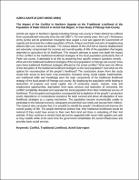| dc.description.abstract | AZIKU SANTUS (2007-MO93-10084)
The Impact of the Conflict in Northern Uganda on the Traditional Livelihood of the
Population of Pader District in Acholi Sub Region: A Case Study of Patongo Sub-County
Acholi sub region in Northern Uganda including Patongo sub-county in Pader district has suffered
from unprecedented insecurity since the mid 1980‟s. For over twenty years, the Lord‟s Resistance
Army (LRA) and its predecessor insurgents have waged a civil war against the Government of
Uganda and terrorised the civilian population of Gulu, Kitgum and Pader and parts of neighbouring
districts like Lira, Soroti and Kotido. The vicious attacks of the LRA led to massive displacement
and adversely compromised the incomes and overall quality of life of the population that largely
depended on agriculture for its livelihood. This research attempts to assess into depth the impact
of this conflict on the traditional livelihood strategies of the local population particularly that of
Pader sub-county. It attempted to do this by answering four specific research questions namely -
What were the traditional livelihood strategies of the local population in Patongo sub-county? How
were these traditional livelihood strategies affected by the armed conflict? What were the effects
of the disruption of the traditional livelihood strategies on the local population? And what are the
options for reconstruction of the people‟s livelihood? The conclusions drawn from this study
reveal that: access to farm land, crop production, livestock raring, social capital, trade/markets,
and traditional skills and knowledge were the main components of the traditional livelihood
strategy of the local people of Patongo sub-county. By displacing the population while leading to
destruction of property and social capital; loss of productive asserts, markets, trade and
employment opportunities; deprivation from basic services and restriction of movement, the
conflict completely disrupted and separated the local population from their traditional sources of
livelihood. This disruption and separation consequently led to depletion of the people‟s productive
assets, dependence on humanitarian assistance for basic survival and above all adaptation of new
livelihood strategies as a coping mechanism. The population became economically unable to
participate in the national economy, adequately provide their own needs and educate their children.
The research also concludes that, it is possible to rebuild the people‟s livelihood and improve the
overall quality of life. The people themselves believe that, their traditional livelihoods would be
restored if they could have access to their own farm land and there is restocking of their lost
animals; if they continue to receive food aid and be supported with house hold supplies and cash
as they resettle while at the same time the government rehabilitates the social infrastructure and
provides basic social services.
Keywords: Conflict, Traditional Livelihood, Acholi Sub-region | en_US |


